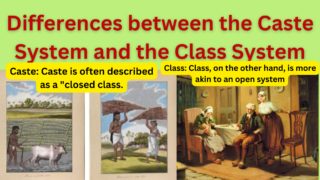
Caste and Class: Understanding the Differences
Caste systems and class systems serve as fundamental components of social stratification and social inequality. These two concepts, however, differ significantly. In this post, we’ll explore the distinctions between them in a comparative manner. As Massiver, Davies, and Bottomor have argued in their respective works, class and caste are as opposite as the North and South Poles. While ‘class’ represents a ‘democratic society’ with equal opportunities, ‘caste’ stands in stark contrast as a system characterized by division, inequality, and the dominance of a particular caste.

Key differences between the Caste System and the Class System presented in table format for easier comparison
| Aspect | Caste System | Class System |
| Concept | Often referred to as a “closed class.” | Typically considered an open system. |
| Definition | Sometimes described as an “extended family.” | Consists of individuals who share a similar economic position and receive similar economic rewards. |
| Type of Stratification | Closed stratification system. | Open stratification system. |
| Quality of Status | Ascribed status, determined by birth. | Achieved status, earned through effort and endeavor. |
| Mobility | Limited mobility, with fixed status. | Room for mobility and change in status. |
| Opportunity | Limited opportunities for change. | Opportunities for individuals to move between classes. |
| Equality | Often lacks equality. | Offers more prospects for equality. |
| Geographical Distribution | Predominantly found in the Indian subcontinent, especially in India. | Found in various societies across the world, particularly in industrialized regions of Europe. |
| Base of Support | Influenced by non-economic factors like religion (karma, reincarnation, ritual purity-impurity). | Primarily dependent on economic differences and control of material resources. |
| Key Characteristics of Caste and Class Systems | -Segmental Division of Society -Hierarchy -Control on Social Relationships -Restrictions of Religion -Limitations on the Selection of Occupation -Endogamous Groups Based on Birth | -No Segmental Division -Hierarchy, but with Greater Mobility -Fewer Restrictions on Social Interaction -Occupation Choice Independent of Birth -Marriage Partner Selection with Fewer Restrictions -Emphasis on Equal Opportunities and Rights -Importance of Achieved Status -Scope for Developing Skills |
For More information watch the following video of the caste system
For More information watch the following video of the Class system
